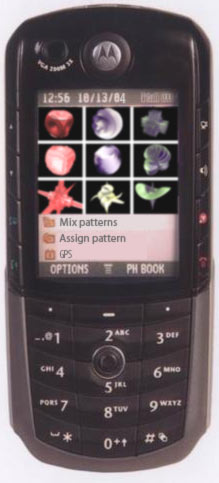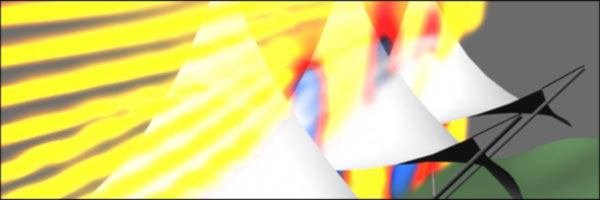| Agent based approach to semi-spatial socioeconomic
interactions |
|
 |
| Fig. 1: Mobile application
for studying location based sociological patterns
(running on Motorola E1000). The 9 icons represent
everyday-life aesthetic schemes to describe emotions
associated with social goods (events, locations,...). |
Several important models of socioeconomic
interactions do not depend so much on spatial distance,
they are rather governed by social distance. Over time,
social distance (connectivity) has increased in importance
for many forms of interaction while spatial distance
(proximity) has decreased in importance. The growing
role of social distance in socioeconomic interactions
has followed advances in transportation and communications
technologies and quite recently, this trend has accelerated
explosively.
Spatial modeling. Several projects,
such as 'Kaisersrot' [1] or [4] have focused purely
on spatial aspects in urban modeling. This allows, for
example, to optimize space usage for two groups of inhabitants,
where group (i) wants to live close to the church and
group (ii) wants to live away from the church.
Non-spatial modeling. In the present
project we build the simulation on top of the space
sociology put forward in [2] and [3]. Although it creates
a lot of references to spatial problems, the primary
focus is on:
1. social goods and humans,
2. relationships and associations,
3. atmospheres (in the sense of Heideggers existential
philosophy).
Consequently the spatial model we are using is distorted
by the above mentioned three non-spatial aspects. Hence
we call it a semi-spatial model.
With the present model we develop a
tool to carry out 'what-if' scenarios in the space sociological
context, with both urban and architectural applications.
Field studies. For
reliable simulations, a large body of space sociological
data, is required. To obtain this information, a simple
to use data harvesting
application was developed in JAVA (see Fig. 1). |
|
| Each individual is characterized by
a list whose elements indicate the individual's attributes.
These attributes are represented by numbers and lists
of numbers. Attributes may include the individual's
name, a list of the names of the members of the individual's
social network and usually one or more of the following:
1. social status
2. wealtch
3. a list of the values of the individual's culturally
determined memes (eg., religious or political affiliation),
4. a list of various other attributes (eg., gender,
race, intelligence, risk preferences, etc.) |
| Defining Relationship Qualities |
|
Relationship qualities are based on everyday-aesthetic
schemes introduced by G. Schulze in [5]. The model
is described in detail in the article Visualisation
and Design in Space Sociology. For simulation
models, these qualities can be distributed among agents
based on statistical analyses, which are also available
from [5].
|
| Introducing Social Network Interaction |
|
To introduce social interaction, we create a function,
that is applied directly to the society list. This
function applies an interaction rule to each individual
and his social network. The argument of the interaction
rule is a nested list whose elements are the attribute
list of an individual and the attribute lists of the
members of his social network.
Since the data
harvesting tool is based on neural networks, it
detects and modifies the rules over time. These rules
are included in the simulation on a continuous basis.
|
| Basic Examples of Social Network Interaction |
|
For purposes of illustration, we introduce two elementary
network interaction rules. These are the only rules
introduced by the author. All other rules of the simulation
are generated by the server
through neural networks.
The first, emulate, models the effect
of emulating those with higher status in one's social
network. The second interaction rule, friendsOfFriends,
provides an individual with a list of individuals
who are acquaintances of members of his social network.
Emulate:: Each individual in this
society is represented by a four-tuple attribute list
of the form {name, socNetLis, socialStatus, memeLis}
where the first attribute is the person's name, the
second attribute is the list of the names of the members
of her social network, the third attribute is the
social status of the person, and the fourth attribute
is his meme list.
During a time step, each individual locates the person
in his social network who has the highest social status
and changes the value of one of his memes, randomly
selected, to equal the value of the corresponding
meme of that person.
FriendsOfFriends:: This rules take
a nested list containing the attribute lists of a
person and the members of his social network (friends)
and returns a four-tuple consisting of (1) the person's
name, (2) an ordered pair whose first element is the
list of the names of his friends and the second element
is a list of lists of the names of his friends' friends,
(3) his social status, and (4) his meme list.
|
| Data Harvesting Application; Technical Aspects |
|
To feed the simulations with reliable data it is
necessary to gain a reasonable set of data from a
representative number of human agents. Therefore,
an easy to use JAVA application was developed for
mobile phones.
Whenever the human agent experiences something important,
he can use his mobile phone to (i) take a photo and
(ii) describe his immediate associations with the
event. The emotions are described via everyday-life-aesthetic
schemes and the according visualization tool illustrated
in Visualisation
and Design in Space Sociology. The JAVA application
sends these pieces of information together with the
GPS coordinates and the current time back to a central
server.
Pattern detection. The server is
running a pattern detection software based on neural
networks. This is an adaptive algorithm which tries
to figure out patterns in the input data it obtains
from its agents attached via IP. Over time, the algorithm
develops rules with a certain probability which are
included in the simulation. Hence, the more input
comes from human agents, the more reliable the simulation
becomes.
|
|
[1] K. Christaanse, Projekt “Kaisersrot”,
http://www.kaisersrot.com/
[2] Martina Löw, Raumsoziologie, Suhrkamp, 2001
[3] Martina Löw, Die Differenzierung des Städtischen,
Leske & Budrich, 2002
[4] I. Benenson, S. Aronovich, S. Noam, Let’s
talk objects: generic methodology for urban high-resolution
simulation, Computers, Environment and Urban Systems,
2004.
[5] Gerhard Schulze, Die Erlebnisgesellschaft, Kultursoziologie
der Gegenwart, Campus Fachbuch, 2000
|


